Ready to turn your yard into a beautiful, well-kept paradise? The first step is picking the right lawn mower for you. Ask yourself: Which lawn mower is perfect for your yard’s size and the land it’s on?
After carefully looking at 14 walk-behind mowers and 6 riding mowers, we found the best ones for every need. We tested them in yards from tiny to huge. No matter if your yard is small or large, our recommendations will help it look great.
Types of Lawn Mowers
Homeowners have many choices when it’s time to cut the grass. They can pick from gas, electric, or battery-powered mowers. Each type comes with its own benefits. We will look more closely at these lawn mowers.
Gas-Powered Mowers
For a long time, gas-powered lawn mowers were the main option. They’re strong, reliable, and cost-effective. Gas mowers can move by themselves, chop up grass, and clean themselves. They’re great for big lawns. Yet, they have downsides like pollution, maintenance needs, and handling gas and oil.
Electric Corded Mowers
Corded electric mowers are a good choice for smaller lawns. They cut and trim well without needing gas or oil. But, you need to manage the power cord carefully so you don’t trip over it.
Battery-Powered Mowers
Recently, battery powered mowers have gained popularity because of better lithium-ion battery tech. These cordless electric mowers are strong, lightweight, and eco-friendly. With some, you might not even notice the difference from gas mowers. They last a long time, move by themselves, and don’t need cords or gas.
Top Picks for Lawn Mowers
Choosing the right lawn mower can seem hard with so many choices. We tested multiple top-rated best lawn mowers, top rated lawn mowers, and consumer reports lawn mowers. This was to help you find what’s best for you.
We did a lot of research and testing to pick the best lawn mowers. Our top choices include:
- Ego Power+ 21-inch Self-Propelled Mower – It’s the best overall because of its great cutting and easy to use features.
- Greenworks 16-inch Corded Electric Mower – The top budget pick, it works well and won’t break the bank.
- Toro 22-inch Self-Propelled Mower – The best self-propelled mower offers easy use and great movement.
- Ryobi 40V 21-inch Battery-Powered Mower – As the best battery powered, it’s cordless and can mow for a long time.
- John Deere S100 42-inch Riding Mower – It’s the best riding mower, with a strong engine and a wide cutting area.
We chose these mowers after reviewing how well they cut, how long they last, how easy they are to use, and their value. From small yards to big lawns, you’ll find one of these best lawn mowers perfect for you. They promise a great mowing experience.
| Mower Model | Price | Power Source | Deck Size | Run Time |
|---|---|---|---|---|
| Ego Power+ 21-inch Self-Propelled Mower | $579 | Battery-powered | 21 inches | Up to 75 minutes |
| Greenworks 16-inch Corded Electric Mower | $297 | Corded electric | 16 inches | Unlimited (corded) |
| Toro 22-inch Self-Propelled Mower | $430 | Gas-powered | 22 inches | N/A |
| Ryobi 40V 21-inch Battery-Powered Mower | $599 | Battery-powered | 21 inches | Up to 45 minutes |
| John Deere S100 42-inch Riding Mower | $1,599 | Gas-powered | 42 inches | N/A |
We carefully tested these top rated lawn mowers to make sure they meet your expectations for performance, strength, and value. We have recommendations for every need, from compact electric models to powerful gas ride-ons.
Choosing the Right Lawn Mower for Your Yard
Think about your lawn size when picking a lawn mower. If your yard is half an acre or less, go for a push mower. Up to an acre, a self-propelled mower is a good choice. For lawns bigger than an acre, choose a riding mower.
If your grass is short or tall, push mowers do the job. They are great for lighter work. Self-propelled mowers, on the other hand, are for bigger lawns and save you effort. The type of terrain and if you have any obstacles in your yard matters too. This should also help pick your lawn mower. Mowers with self-propelling and height adjusting features handle slopes and turn around trees and flower beds easier.
Lawn Size Considerations
- Push mowers are best for lawns up to a half-acre
- Self-propelled mowers work well for lawns up to an acre
- Riding mowers are recommended for yards over an acre
Terrain and Obstacles
Look at what makes your yard unique. Things like slopes, uneven ground, and trees, flower beds, and other obstacles matter. This helps in choosing a mower that fits your yard well. Mowers with self-propelled and height adjusting features can face these challenges.
| Lawn Size | Recommended Mower Type |
|---|---|
| Up to 1/2 acre | Push mower |
| Up to 1 acre | Self-propelled mower |
| Over 1 acre | Riding mower |
Think about your lawn size and what the land is like. This helps in making a smart choice. Choose the lawn mower that fits your needs the best.
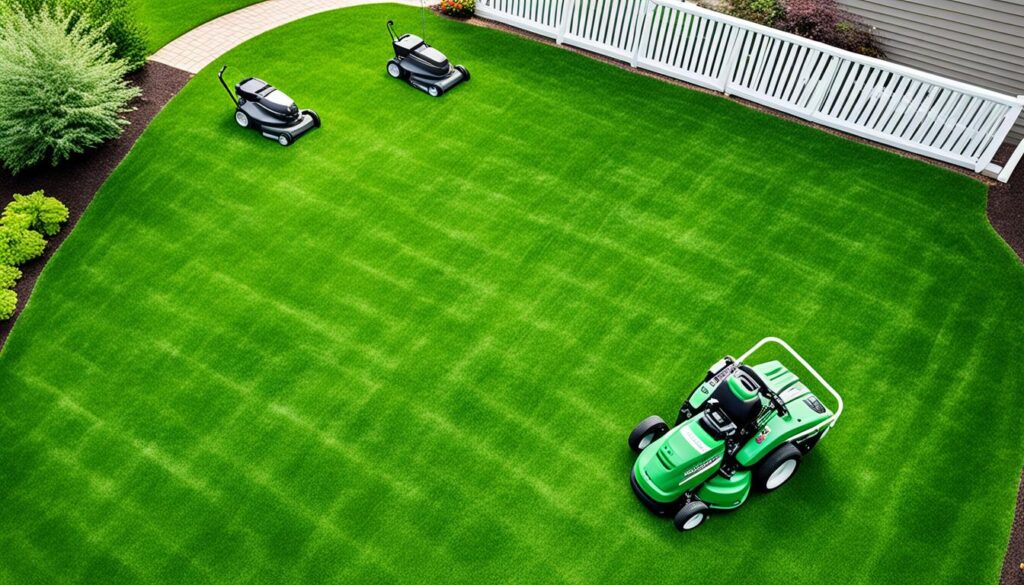
Lawn Mowers: Push vs. Self-Propelled
There are two key types of walk-behind mowers: push mowers and self-propelled mowers. Each type serves different lawn care needs. Knowing the differences can guide you to the best choice for your yard.
Push Mowers: Compact and Convenient
Push mowers are smaller, lighter, and cheaper than self-propelled mowers. They need you to push them to move, which works well for small, flat lawns. Yards under ½ acre find them a great fit due to their easy handling and storage. Gas-powered push mowers can last over 10 years with good care. Meanwhile, battery-powered ones might need a battery update after 5 years.
Self-Propelled Mowers: Effortless Mowing
Self-propelled mowers move forward themselves and are better for bigger yards or those with hills. They take the hard work out of mowing. This means you can mow more with less effort. A well-cared-for self-propelled gas mower can live for 10 years. For a push mower with a different power source, it might last up to 15 years.
| Feature | Push Mowers | Self-Propelled Mowers |
|---|---|---|
| Cost | More affordable | Generally more expensive |
| Maneuverability | Lightweight and easy to maneuver | Heavier, but self-propulsion makes them easier to guide |
| Terrain Handling | Suitable for flat, small yards | Better suited for larger yards, hills, and slopes |
| Effort Required | Requires more physical effort from the user | Reduces physical strain on the user |
| Versatility | Offer bagging, mulching, and side-discharge options | Provide a wide range of cutting and discharge options |
Choosing between a push and self-propelled mower depends on your lawn’s size, shape, and your liking. Push mowers work great for small, even yards. Self-propelled mowers are better for larger, rougher terrains. Learn about each mower’s benefits to find the best fit for you.
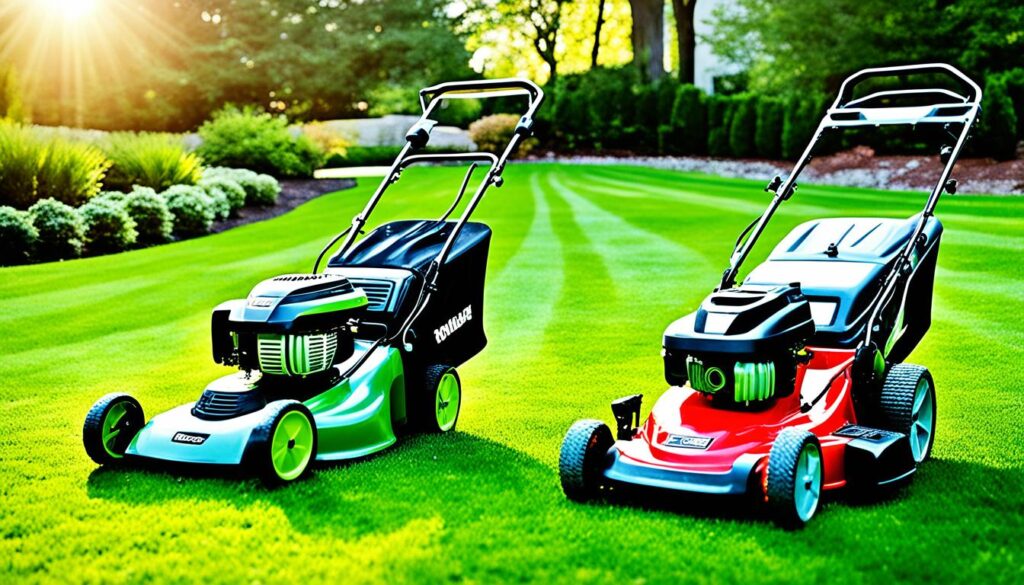
Lawn Mower Features to Consider
Choosing the right lawn mower involves looking at several important features. The cutting width, which is how wide the mower cuts, is a big deal. For those with medium to large lawns, a 20-22 inch deck is great. It lets you mow quicker. But for smaller areas, a 16-inch deck is easier to move around, even though it takes longer.
Another crucial feature is the mower’s ability to adjust cutting height. This helps keep your lawn healthy and looking good. Mowers with adjustable height can cut grass at different lengths, from 1.5 to 4 inches. Having easy controls to set the right height is key to a good cut.
Bagging, Mulching, and Side Discharge Options
Lawn mowers come with various clipping management options. You can choose to bag clippings, mulch them, or let them discharge to the side. Bagging is tidy since it collects all the cut grass. Mulching is good for the lawn because it puts nutrients back. And side discharge throws the clippings away from the mower’s path. Think about what works best for you and your lawn when choosing.
| Feature | Benefit |
|---|---|
| Larger Mower Deck Size (20-22 inches) | Covers more ground per pass, suitable for medium to large yards |
| Adjustable Mowing Height (1.5 to 4 inches) | Allows for customized cutting length to maintain a healthy lawn |
| Bagging, Mulching, and Side Discharge Options | Provides flexibility in managing grass clippings based on personal preferences |
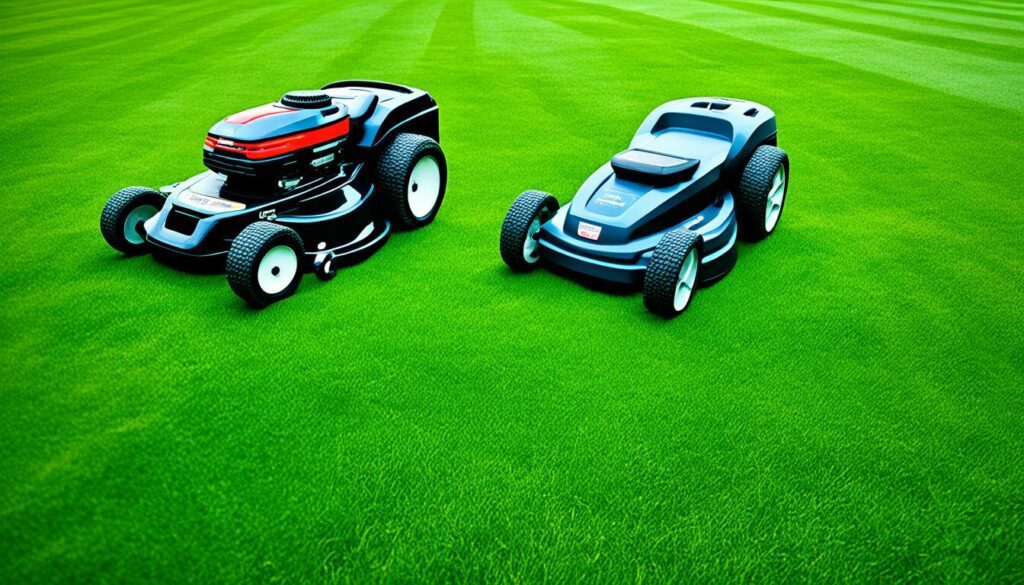
It’s important to think about these features when picking out a lawn mower. Choose one that not only fits your lawn size but also your lawn care style.
Lawn Mowers: Maintenance and Care
The key to a long-lasting mower is proper care. Regular cleaning, blade sharpening, and oil changes keep it running well. Following the maker’s advice means a great mower and a beautiful lawn.
Cleaning the Lawn Mower
Always clean under the mower deck. Debris can stop air movement and lower cutting quality. Use tools to clean, making sure to stay safe by unplugging the spark plug.
Sharpening the Blades
Sharp blades give a neat cut. Dull blades damage grass, making it look bad. Sharpen your blades at least yearly, or if the cut changes. Do it yourself or get them sharpened by a pro.
Changing Oil and Filters
Regular oil and filter changes are key. Check the manual for the right oil and when to change it. Also, change the spark plug yearly for easy starts and good burning.
Storing the Lawn Mower
Before storing your mower, clean it well and empty the gas. Fold it to save space. Applying fogging oil to the engine helps prevent rust.
Do these steps to keep your mower in top condition. This means a beautiful lawn year after year.
| Maintenance Task | Frequency | Cost |
|---|---|---|
| Oil Change | Annually or every 50 hours | $5 – $15 |
| Spark Plug Replacement | Annually or every 100 hours | $5 – $10 |
| Blade Sharpening | Annually or as needed | $20 – $30 |
| Air Filter Replacement | Annually or as needed | less than $10 |
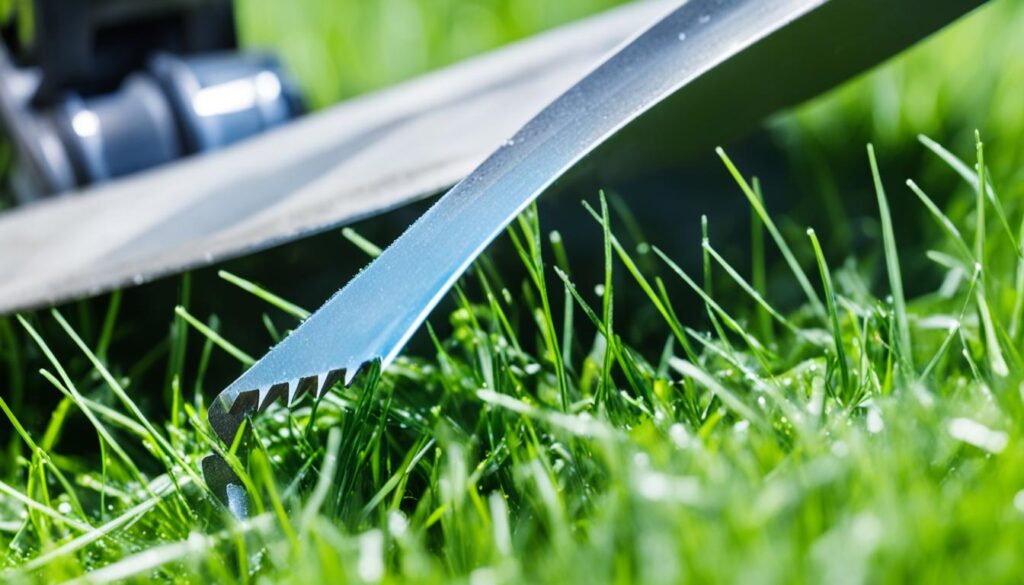
Electric Lawn Mowers: Advantages and Disadvantages
Battery-powered electric lawn mowers are becoming more popular. They offer an eco-friendly choice over traditional gas mowers. These electric mowers don’t need gas or oil, which means they don’t produce emissions. But, it’s important to look at the battery life and charging factors before buying.
Battery Life and Charging
Modern electric mowers can work for 60 to 70 minutes with one charge. This is good for small to medium yards. If you have a big yard, you might need an extra battery. This will help you finish the job without waiting for a recharge.
It takes a few hours to fully charge electric mowers. Gas mowers, in comparison, fill up in minutes. Some electric mowers get around this by offering quick-swap battery systems. This way, you can change to a new battery and keep mowing without long breaks.
| Feature | Gas-Powered Mowers | Electric Mowers |
|---|---|---|
| Noise Level | 95 decibels | 75 decibels |
| Emissions | Equivalent to driving a car for 300 miles per hour of operation | Zero emissions |
| Refueling Time | A few minutes | Several hours to fully recharge |
| Maintenance | Requires regular oil changes and filter replacements | Requires less routine maintenance |
When looking at electric mowers, the battery runtime and charging time are key. Think about the size of your yard and how often you’ll use it. This will help you pick a model that meets your needs best.
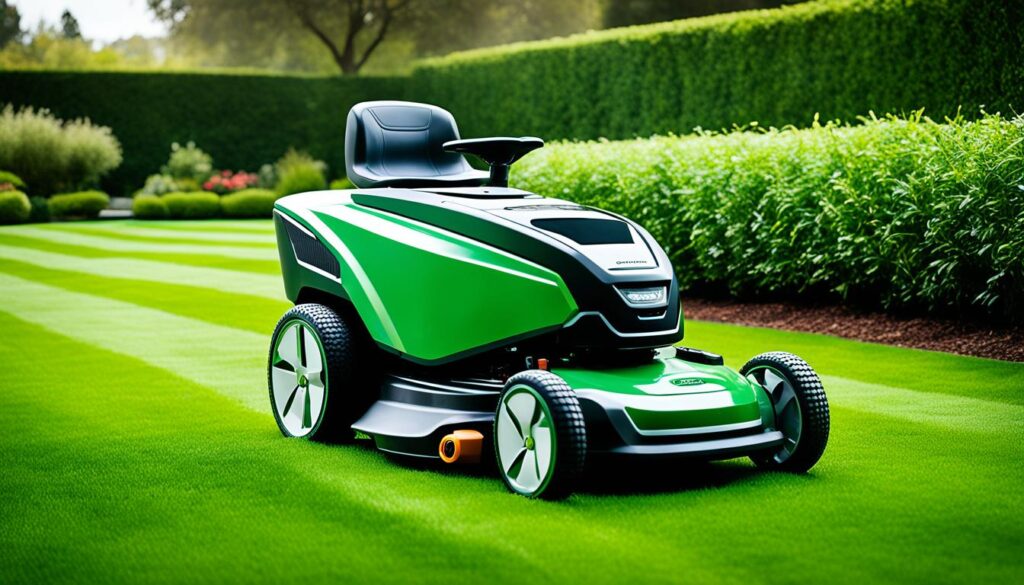
Gas Lawn Mowers: Pros and Cons
Gas lawn mowers have been a top pick in lawn care for a long time. They have their good points, but there are also some bad points. If you’re choosing between gas lawn mowers and the new electric ones, take your time. It’s smart to carefully look at what’s good and not so good about each.
The Pros of Gas-Powered Mowers
- Power and Performance: These mowers have strong engines. They can cut larger yards and rough grass easily. Thick, overgrown grass? No problem for a gas mower.
- Reliability: Gas mowers are often more dependable than electric ones. They don’t need to stop and recharge as often. This can be a big plus for some folks.
- Affordability: In general, gas mowers can be cheaper. They’re less of a hit to the wallet at first, and for maintenance. Plus, their parts are usually not as costly as electric mower parts.
The Cons of Gas-Powered Mowers
- Emissions and Environmental Impact: Unfortunately, gas mowers are not great for the planet. They put out harmful air and greenhouse gases. This makes them less green than electric mowers.
- Maintenance and Fueling: Keeping a gas mower in good shape requires regular care. This includes changing the oil and air filters. Also, they need gas and oil to run, which means more work for you and more money spent.
- Noise and Vibration: Gas mowers can be loud and shaky. This can bother people using them and people nearby. It’s something to think about if you live in a close community.
If you’re looking for something friendlier to the earth, electric mowers might be a better choice. These mowers are quieter, need less maintenance, and don’t release direct emissions. That’s a win for not only your ears but also the planet.
| Feature | Gas-Powered Mowers | Electric Mowers |
|---|---|---|
| Power | More powerful engines for handling tough conditions | Typically less powerful than gas-powered models |
| Runtime | Longer runtime without the need for recharging | Limited runtime, requiring more frequent recharging |
| Maintenance | Require regular maintenance, such as oil changes and air filter replacements | Require less maintenance, with no need for oil changes or air filter replacements |
| Emissions | Contribute to air pollution and greenhouse gas emissions | Zero direct emissions, making them more eco-friendly |
| Noise | Louder operation, which can be disruptive | Quieter operation, providing a more peaceful mowing experience |
| Cost | Typically more affordable upfront and in terms of replacement parts | May have higher upfront costs, but can be more cost-effective in the long run due to reduced maintenance and fuel expenses |
Choosing between gas and electric lawn mowers boils down to your needs and lawn size. Think about what matters most to you. By carefully comparing the advantages and disadvantages, you can pick what’s right for you and the environment.
Riding Lawn Mowers: When to Consider One
A riding lawn mower is great for yards over an acre. It makes mowing much easier and faster than push mowers. You can easily mow more ground quickly. The zero-turn mower is especially good for this.
Zero-Turn Mowers
Zero-turn mowers are very maneuverable, with a turning radius of 0 inches. They’re perfect for moving around things like trees and gardens. They have a unique steering system that lets them turn sharply. But, they are usually pricier than other riding mowers.
Choosing the right mower depends on your lawn’s size. For half to one acre, a 42-inch deck and a 14-horsepower engine are great. Yards up to two acres need a little bigger, up to 46 inches with 14 to 16 horsepower. For bigger than three acres, you’d want a garden tractor. It should have a 46 to 54-inch deck and 18 to 24 horsepower.



